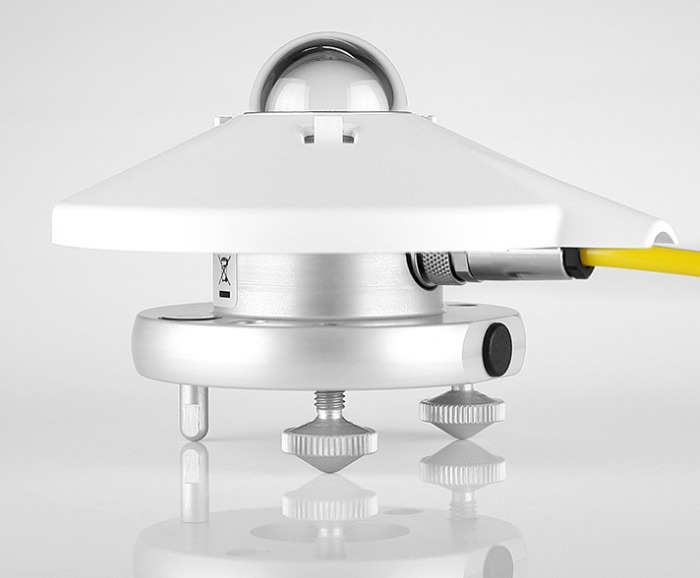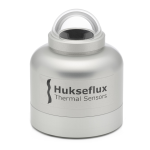
Compatible with most Campbell Scientific data loggers






Overview
The CMP3-L, manufactured by Kipp & Zonen, is an ISO-second-class pyranometer that monitors solar radiation for the full solar spectrum range. It produces a millivolt signal that is measured directly by a Campbell Scientific data logger. The CMP3-L can provide solar radiation measurements for a variety of meteorological applications.
Read MoreBenefits and Features
- Includes a white snap-on sun shield that reduces the sensor's temperature
- Measures reflected solar radiation when inverted
- Provides measurements in direct sunlight, under plant canopies, when the sky is cloudy, and in artificial light
- Includes bubble level and leveling screws, eliminating the need for a separate leveling base and simplifying installation
- Acceptable for providing the solar radiation data used in stability estimations
- Dome protects thermopile and allows water to roll off of it
- Designed for continuous indoor and outdoor use
Images



Detailed Description
The CMP3-L measures solar radiation with a high-quality blackened thermopile protected by a dome. The blackened thermopile provides a flat spectral response for the full solar spectrum range, which allows the CMP3-L to be used under plant canopies or lamps, when the sky is cloudy, and for reflected radiation measurements.
The CMP3-L includes a white snap-on sun shield that reduces the sensor's temperature. It also has a bubble level and adjusting leveling screws, which enable the sensor to be leveled without using a leveling base.
The CMP3-L produces a millivolt signal that is measured directly by a Campbell Scientific data logger.
Two CMP3-L pyranometers can be mounted back-to-back to make a low-cost albedometer. Contact Campbell Scientific for more information.
Specifications
| Sensor | Blackened thermopile protected by a dome |
| Measurement Description | Monitors solar radiation for the full solar spectrum range |
| Spectral Range | 300 to 2800 nm |
| Maximum Irradiance | 2000 W/m2 |
| Sensitivity | 5 to 20 µV/W/m2 |
| Operating Temperature Range | -40° to +80°C |
| Temperature Dependence | ±5% (-10° to +40°C) |
| Non-Linearity | < ±2.5% (0 to 1000 W/m2) |
| Tilt Response | < ±2% at 1000 W/m2 (±80°) |
| ISO Classification | Class C (second class) |
| Dome Diameter | 3.2 cm (1.3 in.) |
| Width | 7.9 cm (3.1 in.) |
| Height | 6.7 cm (2.6 in.) |
| Weight | 600 g (1.2 lb) with 10 m (32.8 ft) cable |
Compatibility
Note: The following shows notable compatibility information. It is not a comprehensive list of all compatible or incompatible products.
Data Loggers
| Product | Compatible | Note |
|---|---|---|
| CR1000 (retired) | ||
| CR1000X | ||
| CR300 | ||
| CR3000 (retired) | ||
| CR310 | ||
| CR350 | ||
| CR6 | ||
| CR800 (retired) | ||
| CR850 (retired) |
Additional Compatibility Information
Mounting
The CMP3-L includes a bubble level and adjusting leveling screws, which allow the sensor to be leveled without using a leveling base. The CM225 Solar Sensor Mounting Stand is typically used to attach the sensor to a mast, crossarm, or pole (1.0 in. to 2.1 in. outer diameter). The CM225 consists of a rectangular plate, mounting bracket, U-bolts, washers, lock washers, and nuts. The CMP3-L should be mounted away from all obstructions or reflective surfaces that might adversely effect the measurement.
Alternatively, the CM245 Adjustable Angle Mounting Stand may be used. It includes slots that can be adjusted to any angle from horizontal to vertical.
Documents
Brochures
Manuals
Frequently Asked Questions
Number of FAQs related to CMP3-L: 10
Expand AllCollapse All
-
If the dome becomes damaged, contact Campbell Scientific or Kipp & Zonen to discuss replacing the dome. The sensor will need to be sent to Kipp & Zonen for any repairs.
-
This may be caused by conditions in which the dome of the sensor is warmer than the thermopile. Most users see a small negative value at night. This offset, as it is commonly termed, can be important for monitoring the performance of the sensor.
-
No. The sensor needs to be connected to a data acquisition system, such as a Campbell Scientific data logger.
-
The CMP3-L has a passive thermopile that produces a small analog voltage that can be equated to a representative amount of incident solar radiation. Campbell Scientific recommends connecting the leads of the CMP3-L to a Campbell Scientific data logger through a differential analog input terminal.
-
Not every sensor has different cable termination options. The options available for a particular sensor can be checked by looking in two places in the Ordering information area of the sensor product page:
- Model number
- Cable Termination Options list
If a sensor is offered in an –ET, –ETM, –LC, –LQ, or –QD version, that option’s availability is reflected in the sensor model number. For example, the 034B is offered as the 034B-ET, 034B-ETM, 034B-LC, 034B-LQ, and 034B-QD.
All of the other cable termination options, if available, are listed on the Ordering information area of the sensor product page under “Cable Termination Options.” For example, the 034B-L Wind Set is offered with the –CWS, –PT, and –PW options, as shown in the Ordering information area of the 034B-L product page.
Note: As newer products are added to our inventory, typically, we will list multiple cable termination options under a single sensor model rather than creating multiple model numbers. For example, the HC2S3-L has a –C cable termination option for connecting it to a CS110 instead of offering an HC2S3-LC model.
-
Most Campbell Scientific sensors are available as an –L, which indicates a user-specified cable length. If a sensor is listed as an –LX model (where “X” is some other character), that sensor’s cable has a user-specified length, but it terminates with a specific connector for a unique system:
- An –LC model has a user-specified cable length for connection to an ET107, CS110, or retired Metdata1.
- An –LQ model has a user-specified cable length for connection to a RAWS-P weather station.
If a sensor does not have an –L or other –LX designation after the main model number, the sensor has a set cable length. The cable length is listed at the end of the Description field in the product’s Ordering information. For example, the 034B-ET model has a description of “Met One Wind Set for ET Station, 67 inch Cable.” Products with a set cable length terminate, as a default, with pigtails.
If a cable terminates with a special connector for a unique system, the end of the model number designates which system. For example, the 034B-ET model designates the sensor as a 034B for an ET107 system.
- –ET models terminate with the connector for an ET107 weather station.
- –ETM models terminate with the connector for an ET107 weather station, but they also include a special system mounting, which is often convenient when purchasing a replacement part.
- –QD models terminate with the connector for a RAWS-F Quick Deployment Station.
- –PW models terminate with the connector for a PWENC or pre-wired system.
-
Many Campbell Scientific sensors are available with different cable termination options. These options include the following:
- The –PT (–PT w/Tinned Wires) option is the default option and does not display on the product line as the other options do. The cable terminates in pigtails that connect directly to a data logger.
- In the –C (–C w/ET/CS110 Connector) option, the cable terminates in a connector that attaches to a CS110 Electric Field Meter or an ET-series weather station.
- In the –CWS (–CWS w/CWS900 Connector) option, the cable terminates in a connector that attaches to a CWS900-series interface. Connection to a CWS900-series interface allows the sensor to be used in a wireless sensor network.
- In the –PW (–PW w/Pre-Wire Connector) option, the cable terminates in a connector that attaches to a prewired enclosure.
- In the –RQ (–RQ w/RAWS Connector) option, the cable terminates in a connector that attaches to a RAWS-P Permanent Remote Automated Weather Station.
Note: The availability of cable termination options varies by sensor. For example, sensors may have none, two, or several options to choose from. If a desired option is not listed for a specific sensor, contact Campbell Scientific for assistance.
-
Because of the loss of IR radiation, nearly all thermopile instruments typically have a negative offset. This offset is most easily visible at night-time, when a small negative value is read instead of zero. This same offset is present during the daytime, but it is not as visible because of the large solar signal.
Another common issue involves leveling an instrument. Leveling a thermopile instrument can cause errors in the direct beam component because the cosine response is not correct. These errors are more notable when the sun is close to the horizon because the angle is so shallow.
-
The LP02-L is a sensor manufactured by Hukseflux, whereas the CMP3-L is manufactured by Kipp & Zonen. Both sensors meet the ISO classification of a Second Class pyranometer.
-
To incorporate a sensor that is compatible with wireless sensor interfaces into a wireless network, a CWS900-series wireless sensor interface is needed, as well as an A205 CWS-to-PC interface to configure it.
Privacy Policy Update
We've updated our privacy policy. Learn More
Cookie Consent
Update your cookie preferences. Update Cookie Preferences

